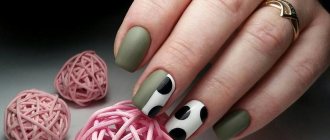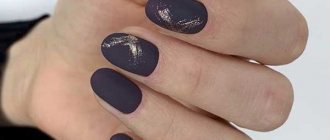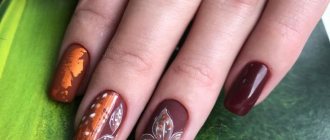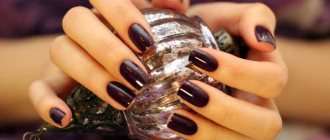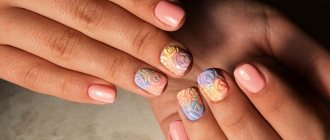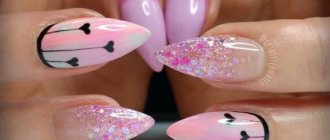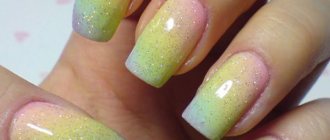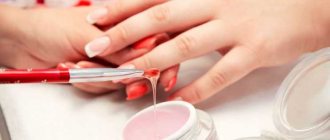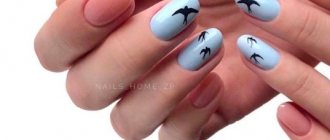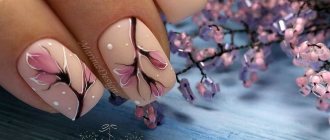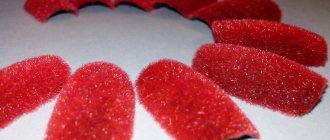Peculiarities
The trend of naturalness is actively developing in the fashion industry.
The main idea of a manicure without using a coating is to give your nails a neat look and present their beauty as naturally as possible. In this case, you can change the shape of the nail plate.
The ideal options are oval and circle. These are the most versatile and common forms, judging from the point of view of practicality and appearance.
When choosing such design options, it is recommended to opt for a short length , otherwise nails without varnish may often break. Don't forget that varnish is an additional layer that strengthens your nails, but without it many girls and women feel much more comfortable.
Try to minimize contact with water and other liquids and detergents.
Uncoated nail plates are subject to the influence of various external factors, including unfavorable ones. For example, dampness makes them more brittle.
Save time
Began! - you say. At first, everyone talked about saving time with gel polish, saying that I did it once 3-4 weeks and forgot. Yes it is. But it is logical that walking without any covering at all is even more economical. Previously, it was necessary to set aside a whole half day for this, and as luck would have it, the week when the manicure needs correction is the busiest. The law of meanness in its glory. I wasted time on the road, because after moving I didn’t want to change the specialist, plus time on the procedure itself.
Now I don’t even have to think about how to squeeze a manicure into my schedule. I just file my nails between times, and with good nutrition, the cuticle easily moves back. Well, in general, after opening manicure salons, I just want to go for a manicure without coating.
How to determine the disease by fingernails
To determine the health of your fingernails, you need to carefully examine the plates. Knowing their normal state, you can notice some deviations. During nail diagnostics, changes in the following characteristics indicate the presence of problems in the body:
- plate colors;
- shape or relief of the nail surface;
- lunula states;
- structures of the nail plate.
Nail color and disease
A healthy nail plate is pink. If it suddenly begins to change its shade, then this is a clear sign of a problem in the body. In this case, diseases of the fingernails are identified by the following diagnostic signs:
- Two-color plate. Its upper part is much darker than the lower part, which indicates kidney disease and renal failure.
- A dark stripe dividing the nail in half. Talks about the development of a malignant human skin tumor – melanoma.
- Brown shade. It is a signal of diabetes mellitus, diseases of the endocrine system, kidney failure, Addison's disease.
- Leukonychia is the appearance of small white spots on the plate. Develops against the background of a lack of calcium, iron and zinc. The body also lacks vitamins C, E and A. When spots grow and take the form of stripes, this indicates protein deficiency, poor circulation, kidney failure, and problems with the colon.
- Sineva. Indicates to a person pathologies of the respiratory system, including infectious diseases of the lungs. If a blue color appears at the base of the plate, then the diagnosis may be diabetes mellitus.
- Completely white nail plate. Appears in patients with liver cirrhosis or diseases of the gastrointestinal tract.
- Yellow coloring of nails. They acquire this shade in case of liver disease and poor digestion, pathologies of the lymphatic system or lungs.
- Redness of nails. Occurs when the number of red blood cells – erythrocytes – increases.
- Cloudy yellowish color. It speaks of a fungal infection if, against the background of a change in shade, there is a thickening of the plate and its separation from the bed.
Shape and relief of the nail plate
In addition to color changes, some diseases may cause deformation of the plate. Diagnosis of fingernails allows one to identify the following associated ailments described in the table:
| Changes | What pathologies are indicated? |
| Convex nail that looks like a watch glass | Is a sign of chronic liver disease or heart weakness. It is also observed in blood diseases, thyroid diseases, congenital pulmonary tuberculosis, hepatitis, colitis, and malabsorption in the intestines. In rare cases, it may indicate the onset of cancer. |
| Concave nail that looks like a spoon | It is a sign of iron deficiency in the body. |
| Flat nail plate, split at the end | Indicates a helminthic infestation. |
| Triangular nail | It is a characteristic sign of spinal diseases. |
| Hole nail | Indicates pathologies of the spleen. |
| Short flat nail with elevation | Indicates organic heart disease. |
| Longitudinal grooves | Appear against the background of the development of rheumatism or inflammation of the teeth and sinuses. |
| Transverse frangible grooves | They signal pathologies of the liver and gastrointestinal tract, symptoms of spleen diseases. Often, transverse grooves appear due to a lack of zinc in the body. |
| Arced lines | They develop due to a lack of protein. |
| Small dimples throughout the plate | They talk about the beginning of inflammation in the joints, accompanying psoriasis. |
Nail hole
When diagnosing nails, the condition of the lunula is also taken into account. Its absence on at least one finger and a pale nail bed are a sign of decreased hemoglobin and red blood cells. These are diseases such as anemia and anemia. If the hole has become thinner or completely disappeared on a certain finger, then this also indicates problems in the body:
- On the thumb. The hole here reflects the condition of the skull and brain. If it disappears, then the person has serious problems with his head.
- On the index finger. On it, the hole disappears in diseases of the liver, lungs, large intestine and gynecological problems.
- On average. The disappearance of the hole here indicates diseases of the circulatory system, problems with blood vessels and pressure.
- On the nameless one. The hole on this finger reflects the state of the lymphatic system and metabolism.
- On the little finger. Here the lunula reflects problems with the small intestine and heart rhythm disturbances and other heart diseases.
Grooves and stripes
Transverse grooves detected by diagnostics are often a sign of improper hand care. In addition, they may appear due to stress, an infectious or other disease. A lack of zinc in the body and poor nutrition also manifests itself as grooves on the nail plates. Longitudinal lines do not appear as often. Their causes may be:
- acute malnutrition;
- severe arterial disease;
- arthritis;
- lichen planus;
- excessive consumption of carbohydrates;
- intestinal diseases;
- lack of iron.
Benefits of manicure at home
Doing your own nails without coating has some benefits.
- Minimum costs. Even if you have to buy a set of tools and consumables for the job, the final cost will be much lower than what you will have to spend on a nail service technician. In addition, tools are used more than once.
- Safety. You will always be sure that you are using safe manicure tools. There is a risk of infection in professional salons.
- Result. By performing a manicure yourself, you have complete control over the final result. It is not always possible to convey the design idea to the master.
- Health. Even the best quality varnishes spoil the condition of the nail plates due to their chemical composition. And without coating, the nails will “breathe”, constantly receiving a sufficient amount of oxygen.
Diagnosis of toenails
Similar to the diagnosis of fingernails, the health status of the feet is also studied. In this case, the following signs are taken into account:
- absence of lunula – decreased number of red blood cells in the blood, anemia;
- two-color nail (light at the base, dark at the edge) – kidney failure;
- discoloration and dark longitudinal stripe – skin cancer (melanoma);
- yellow color against the background of delamination and separation from the nail bed - an advanced stage of a fungal disease.
What is a combined manicure
In a general sense, any manicure that combines several stages from one type of manicure and several from another (you can find all types in this section) can be called combined. However, most often the masters here mean a combination of a hardware manicure with a European or edged manicure. The combination of the device and a classic trimmed manicure is considered the most effective - this is how the most beautiful result is achieved without harm to the nail plate, skin and with virtually no risk of cuts.
Pros and cons of combi manicure
The advantages of this type of manicure include:
- An individual approach to the client, when, depending on the conditions of the hands and nails, the optimal approach to care and treatment is selected.
- A high-quality result obtained by a combination of types of manicure preserves the aesthetic appearance of nails longer.
- When the treatment is done efficiently, then covering the nails (especially under the cuticle) is much easier.
- With a combination manicure, there is a much lower likelihood of burrs and cuts.
The disadvantages worth noting are the following:
- The biggest one is the need to have an expensive manicure machine in your arsenal.
- The second point follows from the first point – the increase in cost of the procedure itself for the client.
- Such a manicure is also more expensive because it requires professional training from the master in courses, and the higher the qualifications, the more expensive the services.
- From the master, this procedure requires not only knowledge, but also practical skills, so that even when examining the nails, they can see which method of combination will be the most productive for them.
- The procedure time increases due to a more scrupulous approach to work.
The popularity of this type of manicure is so high, and the result is so beautiful, that it requires the master to keep up with the times and undergo training in combined manicure. Therefore, recently it has become a little more accessible due to the prevalence of the approach.
First aid for a nail injury: list of manipulations
In case of injury to the nail plate, a number of manipulations should be performed:
- remove shoes, socks (gloves if we are talking about hands);
- hold the injured finger under cool running water or place it in a bowl of water;
- in case of bleeding and severe hematoma, apply a cold compress;
- disinfect the wound with iodine or another antiseptic.
If the nail remains in place during an injury, but is significantly damaged, blood will begin to accumulate under it, which will cause its further detachment. To prevent blood clotting, you should try to remove it from under the nail. After this manipulation, the pain will decrease, and the nail may not come off.
If a nail tears after an injury, you should not expect it to grow back quickly. The entire growth period of the nail plate can last for a year. In order for the new nail to have an attractive appearance, you should wear comfortable shoes (in the case of feet) and avoid possible injuries.
Obviously, nails are an integral part of a healthy human body. Fingers without nails lose not only their aesthetics, but also their functionality. Not only those who are genetically predisposed may face this problem. A simple finger injury can lead to complications and loss of the nail. That is why you should not ignore the means of protecting your hands and feet when performing specific work. If an injury occurs, you should not delay seeking medical help, even if the symptoms do not seem threatening.
Required Tools
Almost every woman has the tools already listed earlier in the table, or some of them. Each of them has its own purpose, application and processing features.
What do you need:
- An orange stick, like a metal pusher, is designed to lift the cuticle and open the subcuticle pocket. It is made of wood and is disposable. It is considered safer for the nail when cleaning pterygium from the surface of the nail plate under the cuticle.
- The pusher is similar in functionality to an orange stick. A special feature of the tool is the ability to choose the shape and size of its spatula. Most often, there is a sharp, flat device on the opposite end of the pusher to clean out the sinuses.
- It is preferable to choose cuticle scissors with long thin blades, slightly rounded (anatomical) in shape. Depending on individual preferences, they can be replaced with tweezers. The sharpening of these tools should be as sharp as possible, so it is better to have a second copy for cutting nails and rough skin.
- Natural nails must be filed using soft abrasive files. Manufacturers of this product offer disposable full-fledged files on a soft base or replaceable files on an adhesive base. The files are attached with the sticky side to a special metal spatula.
Precautionary measures
- Regardless of where you perform the procedure, at home or in the salon, use an antiseptic before starting work. A combined manicure involves working with clippers, which means it is necessary to minimize the risk of infection. How and with what to disinfect, sterilize and clean manicure instruments
- Perform manicures only on healthy nails. The work of a cutter, pusher and nippers is relatively safe, but still affects the nail. When a gash forms or a wound appears, it is unknown how the disease will react;
- Do not use tools after they are dull and do not neglect their treatment. The only exception for sterilization will be paper-based files, which, in fact, are a disposable instrument. Cutters, nippers and pushers must be processed, even if used for home combined manicure.
Overdid it in the gym
Let's start with what healthy nails should look like. Firstly, they are a soft pink shade, even, smooth and shiny; a whitish hole is clearly visible at the cuticle. Secondly, such nails grow well, increasing by about 1 mm per week - this is quite noticeable. Ideally, the nail holes occupy approximately 1/3 of the plate. If they are less or more, this is a bad indicator. In the first option, you probably have a deficiency of vitamin B12 and iron, as well as circulatory problems. In the second, most likely, enlarged sockets are a consequence of excessive physical exertion at work or in the gym, or an indicator of malfunctions of the heart and blood vessels, possible hypotension.
Features of edged manicure
The difference between classic edged manicure and other techniques lies in its name. In the European technique, the cuticle is softened with a remover and then pushed back with an orange stick. Classic manicure uses metal tools (scissors, nippers, spatulas, etc.). The cuticle is first softened and then carefully trimmed. The main disadvantage of this type of cuticle treatment is the possibility of damaging the delicate skin around the nail. There is also a small chance of infection. However, experienced craftsmen masterfully master this technique, and it does not cause any complaints from clients. In addition, as mentioned above, the European technique is not suitable for all girls due to the cuticle being too rough. Masters recommend starting with a classic manicure, and then gradually moving on to a European unedged manicure when the cuticle becomes softer.
Also a distinctive feature of classic manicure is the use of water. Before starting to manipulate the client’s hands, the master prepares a hand bath to soften the cuticle.
The main advantages of classical technology:
- Available for home use;
- Suitable for working with rough cuticles;
- Does not require large expenses;
Disadvantages of trimming technique:
- If you handle the tool carelessly, injury to the cuticle or nail plate may occur;
- After the procedure, hangnails often form.
In general, the technique is simple to perform manicure at home and quite popular.
Anonychia - features of a hereditary disease
This is a rare hereditary disease in which a person has completely or partially missing nails. Pathology can manifest itself both on the arms and legs. In the case of the disease described, in the place where the nail should grow, there is something more reminiscent of the rudiments of the nail plate.
Against the background of a hereditary disease, the patient develops additional abnormalities in the body. This means that he not only has fingers without nails, but also has problems with the skin and hair - the structural component of the epithelium, sebaceous glands and hair is damaged.
Experts do not exclude the possibility that a person may acquire the disease during his or her lifetime. This can occur due to serious injury or complications of a third-party illness. Anonychia, or absence of nails, can also result from a disorder of the patient’s nervous system.
Technique for doing it at home
Manicure without coating (price 400–750 rubles) with the classic (edged) version is available at home. All tools are affordable and will last a long time.
Even a beginner can master this technique by sequentially performing the following steps:
- Lifting the cuticle.
- Opening and cleaning of the subcuticular space.
- Shape sawdust.
- Applying remover.
- Maceration.
- Deep cleaning of the pterygium.
- Removal of rough skin.
- Cuticle cut. Applying oil.
The mandatory sterilization step cannot be performed at home. Therefore, all instruments are used strictly individually, in order to maintain hygiene. Even the safest manicure can cause harm and injury. Excessive pressure, depth, pressure or angle of the instrument can damage the matrix and nail plate. Each stage has its own characteristics and requires a more detailed analysis.
Removing old coating
Removing the old coating is a mandatory step and can be done in two ways: sawing and soaking.
The choice of method depends on the following factors:
- nail conditions;
- material rigidity;
- material thickness;
- available tools.
Soaking involves soaking the artificial surface with a liquid containing a solvent. Varnishes that dry in the open air are wiped with a cotton pad soaked in liquid. It is enough to apply it for 5-10 seconds. The service of coating nails with gel polish is very popular in salons.
When coating with leveling, a layer of base coat is applied under the color coating, forming the correct architecture of the nail. The thin layer and structure of the material allow a special liquid to saturate and soften it. You must first file the top coat and the end with a file for natural nails. This will reduce the soaking time to 15–20 minutes.
A cotton pad cut into several triangles is soaked in removing liquid. Each piece is attached to a nail using foil. The softened coating is scraped off with gentle movements from the surface of the nail. Residues are removed with a buff of soft abrasive. The material must be removed in the direction from the cuticle to the free edge.
When modeling nails, harder materials that cannot be soaked are used.
In this case, it is necessary to note the sawdust technique. For an experienced craftsman with a router and carbide cutters, the procedure will take no more than 20 minutes. To remove the coating at home, you will need a coarse abrasive file and a longer period of time.
Cuticle treatment
First of all, the cuticle needs to be lifted. Light movements of a pusher or an orange stick push it towards the proximal fold. This stage makes it possible to open the subcuticular space, which will allow for a deeper cleaning of this area. Nail technicians recommend that beginners perform lifting in several passes, moving from the sinuses to the center of the nail. The resulting pocket must be cleaned of dry pterygium and adhesives adhering to the nail plate. To do this, short stroke movements are made along the cuticle line from the sinus to the center of the plate.
Before putting your hand into a bath of warm water (water temperature no more than 30–40 C°), modern manicurists apply a cuticle remover. This thick liquid is designed to soften the cuticle and make it easier to remove later. The water in the bath should not be hot, and the exposure time should not exceed 10-15 minutes. Otherwise, when cutting the cuticle, the border of keratinized and dry skin will be poorly visible. This increases the risk of injury.
French manicure classic
A classic French manicure (French) is performed using different technologies: the smile line is drawn freehand with a brush, special stencils are used, the tip of the nail is dipped in acrylic powder or glitter, and a special brush is used for a French manicure. Whatever method you choose, the technique for preparing the nail plate will be approximately the same. The exception is the stage of creating a base: you can use a base and then apply a light gel polish, or you can use special colored translucent bases for a jacket. To draw a smile line, different materials can also be used: thick gel polish or thicker gel paint.
Step-by-step instructions for making a classic French jacket
What do changes in the lunula indicate?
The lunula or socket is the visible part of the nail matrix, which is shaped like a crescent. Located at the base of the nail. Normally, the lunula occupies up to a third of the nail plate and is clearly visible. Its changes are most noticeable on the fingernails. What diseases and disorders can they talk about?
Professional athletes and people who engage in heavy physical labor every day have holes that are too large. Sometimes an increase in its size occurs due to malfunctions of the cardiovascular system, hypotension (low blood pressure).
A decrease in lunula is a symptom of a lack of vitamin B12, iron, and circulatory disorders in the extremities. If it completely disappears, then this indicates problems with the lungs.
For diagnosis, not only the size, but also the color of the lunula is important. If it has acquired a bluish tint, then this is a sign of a malfunction of the liver, and if it is red, it is a sign of heart failure.
"Pitfalls" of classic manicure
- Careless use of cutting tools often leads to cuts. Not only are they very painful and spoil the appearance of the manicure, the main danger lies in the likelihood of infection if the sterilization and disinfection of the tools and hands of the master was not carried out properly. Therefore, pay special attention to the condition of the master’s workplace, whether the tools were opened in your presence, whether the master was wearing gloves - we talk about what else you need to keep in mind when doing a manicure in a salon.
- Many experts insist that the cuticle is a necessary protective barrier created by nature for a reason. It protects the sensitive area of the matrix from the penetration of contaminants and mechanical damage. An inexperienced master, trying to cut the cuticle, can damage the soft nail plate where it is just forming. This can disrupt nail growth and cause grooves and depressions to form.
- After soaking in the bath, the nail plate absorbs water and expands. The applied varnish does not have such mobility and the ability to adapt to changes in the nail plate, so it can begin to chip quite quickly.
Tricky enemy
I don’t think anyone needs to explain what nail fungus looks like, but some points still need to be clarified. A fungal infection can really ruin your nails! First, they begin to break and crumble from the free edge, and if you do not consult a doctor or self-medicate (and fungus is an insidious thing, and you cannot cope with it without a specialist), then the infection can affect almost the entire nail and even its matrix, i.e. .root. This can subsequently lead to impaired nail growth.
Alternatives to the classic edged manicure
In recent years, the so-called European manicure, which is based on the principle of untrimmed cuticle removal, has gained popularity. The European unedged manicure uses a special remover, which is applied to the area around the nails and literally in a minute softens the skin and allows you to remove dry areas of the cuticle and pterygium with an orange stick. Cutting tools in this manicure are used only to remove burrs, and therefore unedged manicure is recognized as the most gentle and safe.
Common mistakes
- When cleaning the pterygium under the cuticle, it is strictly forbidden to tear the cheek of the cutter from the nail. The slightest change in the angle can cause a groove in the plate to be cut, which will heal in about 6 months.
- Be careful when checking the pocket under the cuticle for remains of the pterygium. The resulting gash, which you might not have noticed, as well as the skin growth, will have a whitish tint. When you try to file down what appears to be a growth, you risk filing down the nail even more and deforming the nail plate.
- If at the grinding stage a large uncut piece of cuticle is discovered, it is better to remove it with scissors or nippers. Grinding with a milling cutter will be long and not very pleasant.
Hardware manicure - answering frequently asked questions
Combined manicure, the procedure is not as complicated as it might seem - the most important thing is to find your tools and a comfortable position for your hand. The result of the treatment will be a clean, shiny nail, neat cuticle and velvety skin on the side ridges. Which manicure do you prefer?
What is considered normal or pathological?
Healthy nails have a pale pink color, regular shape, smooth surface with a slight natural shine. If you notice that they have become deformed, changed color, or become covered with grooves or grooves, you need to contact a podiatrist or dermatologist. Fragility, separation, disappearance or enlargement of the nail hole, the appearance of stripes and inclusions often signal serious health problems.
It is important to pay attention to the growth rate of the nail plate. Normally, it takes about 4–6 months to completely change it on the arms, and 8–12 months on the legs. The growth rate depends on a person’s age, physical activity, hereditary factors, and time of year.
What diseases do nails indicate if their growth has slowed down? The reason may be a decrease in thyroid function or a lack of vitamins and minerals. In both the first and second cases, the problem will not be limited to nail diseases. Hair and skin will also be affected. Hair will become brittle, dull, and begin to fall out more rapidly. The skin will lose its healthy color, softness, and will be dry.
Sometimes nail changes are considered normal. For example, as we age, the nail plate gradually thickens. In pregnant and lactating women, nails peel off, become thin and brittle.
Care Tips
Numerous reviews from both clients and the masters themselves indicate that proper, timely and regular nail care simplifies each subsequent manicure procedure.
To ensure that nail care does not cause harm instead of benefit, pay attention to the recommendations regarding their treatment at home.
- Don’t neglect your own cuticle - remember that you need to periodically remove it yourself, even without going to a specialist. If you ignore this recommendation, you will be forced to repeat the manicure more often, and the procedure itself will be longer, more expensive and uncomfortable each time.
- Remove cuticles using special tools. It is recommended to do this in one motion so that it comes off as a single strip - if everything is done correctly, it will maintain a decent appearance for a long time without the formation of burrs.
- It is unacceptable to remove cuticles with bare hands or using sharp nails - there are special cosmetic tools to perform this task. If you do not properly care for them (first of all, regular cleaning and disinfection), you risk getting an infection when removing the cuticle, so a disinfectant should always be at hand.
- Removing cuticles is much easier if you regularly moisturize them with special oil. Moreover, the same procedure somewhat helps to improve the appearance of this part of the nail. Moisturizing must be done daily, even several times, and it is highly undesirable to break the regularity - just skip it a couple of times and the cuticle will return to a hard and unattractive appearance.
- Although the cuticle can spoil the appearance of the nail, it actually plays an important role in the body, protecting the area where the growing nail comes into contact with the skin from the penetration of bacteria. For this reason, it cannot be completely removed - you should always leave a small strip at the very root to avoid the penetration of infections.
- Modern methods involving untrimmed processing are considered to be the best in aesthetic terms - they are guaranteed to provide an even edge to the cuticle and involve a lower risk of injury. At home, everyone, even craftsmen, usually confine themselves to the trimming method, but if possible, you should resort to it as little as possible.
- The body gets used to a certain external influence, and its change, even for the better, can lead to a short-term supposed worsening of the condition. It’s the same with the cuticle - it seems to adapt to one of the removal methods (trimmed or untrimmed), and when changing the technique, unforeseen consequences are possible, such as accelerated growth and a rapid loss of neatness. However, over time, your nails will get used to the new way of doing manicure, so the main thing is just not to alternate them constantly.
- Pre-soaking the nails in many cases reduces the discomfort from performing a manicure - since the nail plate becomes softer, it no longer resists trimming as much, making the procedure painless. However, recently, experts are more often persuading clients to abandon this idea, since water often allows microbes to penetrate into the smallest wounds, and can even become a convenient breeding ground for bacteria that were already on the skin.
Sources
- https://vplate.ru/manikyur/bez-pokrytiya/
- https://modnail.ru/publication/hodit-bez-gel-laka-modno-kakie-plyusy-ya-nashla-dlya-sebya/
- https://Moi-Manikur.ru/vidy-manikyura/kombinirovannyj-manikyur.html
- https://izuminki.com/chto-takoe-kombinirovannyiy-manikyur
- https://lifegirl.ru/manikyur-bez-pokrytiya-foto.html
- https://nails-mag.ru/manikur/kombinirovannyy/
- https://womenshealth.su/kosmetologiya/klassicheskij-manikyur/
- https://MakeUp.ru/article/klassicheskij-manikyur-chto-vhodit-v-eto-ponyatie
- https://vplate.ru/manikyur/kombinirovannyj/
[collapse]
Diagnosis of diseases using fingernails when a pattern appears
Problems in the body are indicated not only by a change in color, but also by the appearance of various patterns in the form of spots, lines, bruises, etc. In a normal state, this should not be observed. A healthy nail plate has a uniform pink color. The appearance of any drawings on it indicates the following diseases:
- White spots. They talk about low hemoglobin, reduced immunity, symptoms of neurosis, and lack of vitamins.
- Black spots. Appear against the background of endocarditis.
- Pairs of horizontal stripes. Observed when there is a lack of protein in the diet. It is excreted in large quantities from the body in case of kidney disease.
- Divided crosswise into 2 halves of different colors - milky and normal. Indicates kidney pathology in an advanced stage.
- A line that did not appear due to mechanical impact. Appears in case of fever and high temperature. Indicates previous illnesses.
- Brown or beige stain. It is a warning about the development of cancer.
- A brown or yellow spot at the edge of the nail plate indicates psoriasis.
- Crumbling grooves or white flake-like spots. They are a sign of fungal diseases.
- Bruising. Observed when there is a mechanical impact on the nail plate. The reason is rupture of the blood vessels underneath and hemorrhage into the soft tissue.
- 6 shameful women's “whys” for which you urgently need to go to the gynecologist
- Benefits for military veterans - a complete list of taxes and services
- Korean carrot grater - how to choose an electric or mechanical one based on quality and cost
